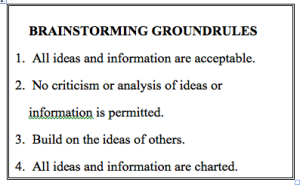Contemporary organizations expect every group within them to provide creative solutions. Groups need to find better ways of doing business as well as expose, analyze, and deal with problems before they even occur.
The best way to find the most effective idea is to first introduce as many ideas as possible. And that means brainstorming. Brainstorming works on the principle that the quantity of ideas increases their quality. The first ideas are typically the most obvious. When brainstormers are fearful of scrutiny and judgment during the brainstorming session, ideas stop flowing before the best ideas come forward. Deferring judgment on ideas improves the volume of participant input and consequently the value.
In my next series of blogs, I will share six brainstorming techniques that are designed to guide the meeting facilitator toward improving the outcome of any organization’s brainstorming efforts.
These techniques include:
- The Old-Fashioned Way
- Mind Mapping
- Storyboarding
- Card Clusters
- STP
- Breaking a Stalemate
Today we’ll focus on Technique #1: The Old Fashioned Way
“Sometimes I need to gather a lot of ideas quickly, especially when a large group of participants is involved. Is there a basic brainstorming technique that will function well under these circumstances?”
#1 The Old Fashioned Way
What Is the Old Fashioned Way?
The Old Fashioned Way is the original brainstorming technique. It is tried and true as a technique that enables participants to input significant amounts of information or ideas in a short period of time. The Old Fashioned Way works well for both small and large groups.
The general rules for the Old Fashioned Way serve as the basis or foundation for the other brainstorming techniques included in this series.
When to Use the Old Fashioned Way
- When you want to generate a large quantity of information before problem solving, decision making, or planning
- When you want to inspire creativity and gather ideas
How to Use the Old Fashioned Way
1. Introduce the topic and purpose o the specific brainstorming session. Remind the group of the ground rules for brainstorming and consider posting these ground rules on a chart, as illustrated below.
2. Begin the discussion by asking a specific open-ended question to focus the discussion. For example: “What should we name our new product?” “What do we need to accomplish before the conference begins?” “What can we do to capture a larger market share?”
Ask your participants to “popcorn” their ideas. (“Popcorn” means allowing participants to voice their ideas in an unorderly and unrestrained sequence.)
NOTE: The facilitator or designated recorder charts all ideas as they are stated.
OPTION: Collect the ideas using a round-robin approach. (Round-robin means that ideas are collected in an orderly fashion, by sequentially asking each person in the room for his or her ideas.)
OPTION: Use two recorders to keep up with the fast flow of ideas.
NOTE: A lull in ideas may occur before a round of new and even more creative ideas. Don’t be afraid of a few minutes of silence. If the group is stuck, take a break or read aloud all the ideas you have collected to that point.
3. When the group feels comfortable that there are no more ideas to add, go through the list of ideas, one by one. Ask the group if anyone needs clarification or further information on what each item means.
Summary
The Old Fashioned Way is the original brainstorming technique. This technique enables your meeting group to generate a large amount of information or number of ideas in a short period of time.
- Introduce the subject.
- Begin the discussion.
- Go through the ideas or information, one by one, to ensure they don’t need any further clarification.
- As appropriate, narrow down the ideas.
Source: Osborn, A. F. 1963. Applied Imagination. New York: Scribner’s.
———————-
NOTE: If you would like to receive e-mail notification when I post additional techniques, please sign up through this link. http://eepurl.com/KILan You may unsubscribe at any time.
